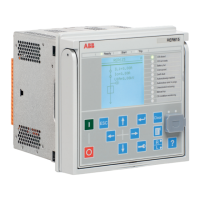Each connected node in the HSR ring must support HSR protocol to ensure smooth
redundancy. Otherwise Ethernet communication is disturbed and might not work.
Single attached nodes can be connected to a HSR ring with a separate redundancy box
(RedBox).
Use correct Ethernet connectors in the IED with HSR. IEDs with HSR
support have three Ethernet connectors and redundant Ethernet ports
are marked as LAN A and LAN B. The third Ethernet port without any
LAN A or LAN B marking is an interlink port which is used as a
redundancy box connector.
IEC 61850
HSR
SMV traffic
Backup 1588
master clock
Managed HSR
Ethernet
switch
Primary
IEEE 1588 v2
master clock
Secondary
IEEE 1588 v2
master clock
(optional)
Managed HSR
Ethernet
switch
GUID-7C56BC1F-F1B2-4E74-AB8E-05001A88D53D V5 EN
Figure 39: Recommended HSR reference topology with SMV and IEEE 1588 v2
The maximum number of IEDs supported in the HSR ring is 30. This
is to keep the ring delay as small as possible for horizontal
applications.
The IED interlink port does not support IEEE 1588 v2 slave devices.
HSR bandwidth is 50 Mbit/s as all messages are doubled for both
directions of the ring.
Section 6 1MRS757809 C
Process bus and IEEE 1588 time synchronization
62 REC615 and RER615
Engineering Guide

